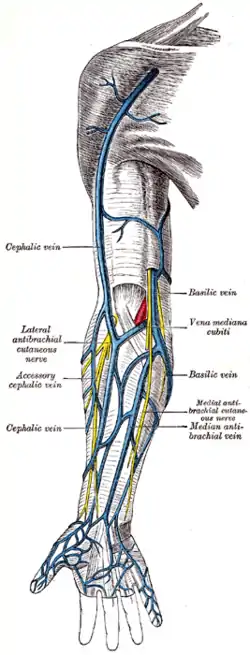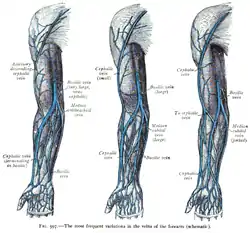Median cubital vein
In human anatomy, the median cubital vein (or median basilic vein) is a superficial vein of the arm on the anterior asepct of the elbow. It classically connects the cephalic vein and the basilic vein.
| Median cubital vein | |
|---|---|
 | |
| Details | |
| Source | cephalic vein |
| Drains to | basilic vein |
| Identifiers | |
| Latin | v. mediana cubiti, v. intermedia cubiti |
| TA98 | A12.3.08.019 |
| TA2 | 4980 |
| FMA | 22963 |
| Anatomical terminology | |
It is routinely used for venipuncture (taking blood) and as a site for an intravenous cannula. This is due to its particularly wide lumen, and its tendency to remain stationary upon needle insertion.
Structure
The median cubital vein is a superficial vein of the arm.[1] It lies on the anterior aspect of the elbow,[2] in the cubital fossa superficial to the bicipital aponeurosis. It bridges the cephalic vein and the basilic vein.[3]
The median cubital vein receives a number of tributaries from the anterior forearm. The median antebrachial vein may or may not drain into the median cubital vein.[3]
The median cubital vein issues a branch - the deep median vein - which pierces the fascial roof of the cubital fossa to join the brachial veins.[3]
Variations
The arrangement of the basilic, cephalic, median cubital, and median antebrachial veins exhibits a wide range of variations. Classically, the median cubital vein bridges the cephalic and basilic veins across the midline to form a H-pattern. However, in many cases, the median cubial vein is absent, instead replaced by a dominant median antebrachial vein that splits into intermediate cephalic and basilic veins to drain in the cephalic and basilic veins, respectively, forming a M-pattern. A number of other patterns exist, including ones where no anastomosis occurs between the basilic and cephalic veins, and ones where the median cubital vein is doubled.[4] When the median cubital vein is large, it transfers most or all blood from the cephalic vein to the basilic vein, so that the cephalic vein is either significantly diminished or altogether absent.[3]
Clinical significance
The median cubital vein becomes prominent when pressure is applied to upstream veins as venous blood builds up.[5]
The median cubital vein is routinely used for venipuncture (taking blood) and as a site for an intravenous cannula.[6] This is due to its particularly wide lumen, and its tendency to remain stationary upon needle insertion.[6] It becomes prominent when pressure is applied upstream, which makes needle insertion easier.[5] Such pressure is created using a tourniquet.[5]
Additional images
 The most frequent variations of the veins of the forearm (schematic).[4]
The most frequent variations of the veins of the forearm (schematic).[4] The median cubital vein, labelled as the median basilic vein.
The median cubital vein, labelled as the median basilic vein. A vacutainer being used to draw blood from the median cubital vein for a blood test.
A vacutainer being used to draw blood from the median cubital vein for a blood test.
See also
References
- Standring, Susan (2016). Gray's anatomy: the anatomical basis of clinical practice (41 ed.). Elsevier Limited. pp. 837–861. ISBN 978-0-7020-5230-9.
- Standring, Susan (2020). Gray's Anatomy: The Anatomical Basis of Clinical Practice (42th ed.). New York. p. 612. ISBN 978-0-7020-7707-4. OCLC 1201341621.
{{cite book}}: CS1 maint: location missing publisher (link) - Hunter, James P.; Barlow, Adam D.; Nicholson, Michael L. (2014). "5 - Access for Renal Replacement Therapy". Kidney Transplantation–Principles and Practice (7th ed.). Saunders. pp. 72–90. doi:10.1016/B978-1-4557-4096-3.00005-2. ISBN 978-1-4557-4096-3.
- Pires, L.; Ráfare, A. L.; Peixoto, B. U.; Pereira, T. O. J. S.; Pinheiro, D. M. M.; Siqueira, M. E. B.; Vaqueiro, R. D.; de Paula, R. C.; Babinski, M. A.; Chagas, C. A. A. (2018-06-01). "The venous patterns of the cubital fossa in subjects from Brazil". Morphologie. 102 (337): 78–82. doi:10.1016/j.morpho.2018.02.001. ISSN 1286-0115. PMID 29625795. S2CID 4662703.
- Sadrzadeh, Hossein; Baskin, Leland; Kline, Gregory (2017). "1 - Variables affecting endocrine tests results, errors prevention and mitigation". Endocrine Biomarkers - Clinicians and Clinical Chemists in Partnership. Elsevier. pp. 1–40. doi:10.1016/B978-0-12-803412-5.00001-X. ISBN 978-0-12-803412-5.
- Lew, K. (2012-01-01), Pawliszyn, Janusz (ed.), "3.05 - Blood Sample Collection and Handling", Comprehensive Sampling and Sample Preparation, Oxford: Academic Press, pp. 95–121, doi:10.1016/b978-0-12-381373-2.00068-5, ISBN 978-0-12-381374-9, retrieved 2020-11-17
External links
- Anatomy photo:07:st-0703 at the SUNY Downstate Medical Center
- Radiology image: UpperLimb:18VenoFo from Radiology Atlas at SUNY Downstate Medical Center (need to enable Java)